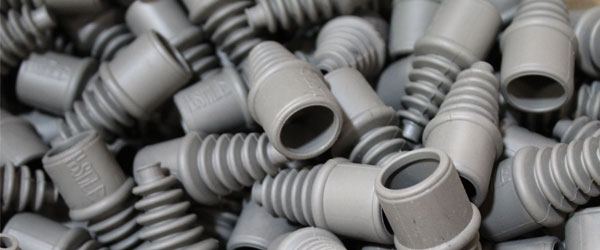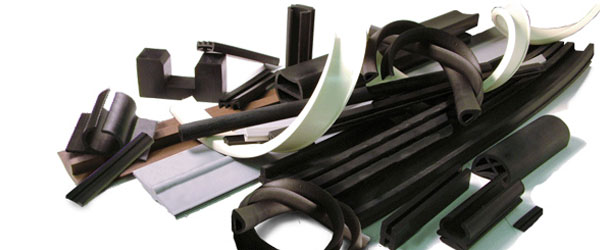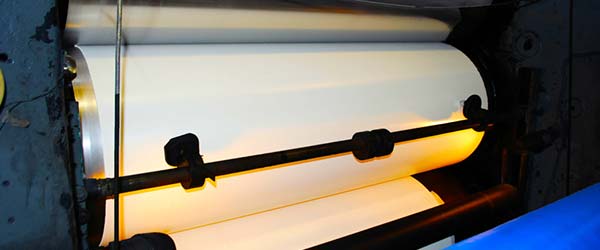Rubber Physical Properties and Characteristics
Rubber Physical Properties
The following chart is provided as a guide only. Speak with us to help you choose the best product for your application.
| Trade Name | NATURAL RUBBER | SBR | NEOPRENE | NITRILE (BUNA-N) | EPDM | SILICONE | VITON® | |
|---|---|---|---|---|---|---|---|---|
| Chemical Name | Polyisoprene | Styrene butadiene | Polychloroprene | Acrylonitrile butadiene | Ethylene-propylene-diene terpolymer | Polysiloxane | Fluorinated hydrocarbon | |
| SAE 1200 & ASTM D-2000 Designation | AA | AA, BA | BC, BE | BF, BG, BK | BA, CA | FC, FE, GE | HK | |
| ASTM D-1418 Designation | NR | SBR | CR | NBR | EPDM | VMQ | FKM | |
| Minimum | -55ºC | -55ºC | -40ºC | -40ºC | -55ºC | -65ºC | -40ºC | |
| Temperature | (-67ºF) | (-67ºF) | (-40ºF) | (-40ºF) | (-67ºF) | (-85ºF) | (-40ºF) | |
| Maximum | 50ºC | 70ºC | 100ºC | 100ºC | 120ºC | 225ºC | 225ºC | |
| Temperature | (122ºF) | (158ºF) | (212ºF) | (212ºF) | (275ºF) | (437ºF) | (437ºF) | |
| Usual Shelf | 5-Mar | 5-Mar | 10-May | 10-May | 10-May | Up to | Up to | |
| Life | years | years | years | years | years | 20 years | 20 years | |
| Advantages | Outstanding elasticityGood flexibility at low temperatures | Very good flexibility at low temperatures | Good resistance to flame | Very good resistance to oils and fuel | Excellent heat, ozone and sunlight resistance | Flexible at extreme temperatures | Excellent resistance to a wide variety of oils, fuel, solvents and acids at high temperatures | |
| Very good resistance to weather, ozone and natural aging | Superior resistance to petroleumbased hydraulic fluids | Very good flexibility at low temperatures | Low compression setExcellent ultraviolet, weather and ozone resistance | Very good impermeability to gases and steam | ||||
| Very good resistance to alkalis and acids | Wide range of service temperatures | Good resistance to alkalis and acids, and solvents | Inert, odourless, tasteless and non?toxic | Very good weather, ozone and sunlight resistance | ||||
| Very good resistance to alkalis and acids | Superior resistance to water and steam | |||||||
| Limitations | Poor heat, ozone and sunlight resistance | Poor heat, ozone and sunlight resistance | Poor to low resistance to aromatic solvents | Low resistance to ozone, sunlight and natural aging | Poor resistance to oils, fuel and to hydrocarbon solvents | Poor abrasion and tear resistance | Will be severely attacked by certain solvents such as esters, ethers and acet | |
| Very little resistance to oils, fuel and to hydrocarbon solvents | Very little resistance to oils, fuel and to hydrocarbon solvents | Limited capacities at low temperatures | Poor resistance to polar solvents | Poor resistance to solvents, alkalis and acids |
Physical Properties by Polymer
| Physical Properties | NATURAL RUBBER | SBR | NEOPRENE | NITRILE (BUNA-N) | EPDM | SILICONE | VITON® |
|---|---|---|---|---|---|---|---|
| Tensile Strength | E | F-G | VG | VG | F-G | VG | VG |
| Ultimate Elongation | VG-E | G | G | G | G | VG-E | F-G |
| Compression Set | G | G | F-G | G | G | VG-E | VG-E |
| Heat Resistance | F | F-G | F-G | G | VG-E | E | E |
| Flame Resistance | P | P | G | P | P | F-G | VG-E |
| Resilience | E | F-G | VG | F-G | G | G | F |
| Abrasion Resistance | E | VG-E | VG-E | VG-E | VG-E | P-F | F-G |
| Water Resistance | E | VG-E | G | VG-E | E | VG-E | G |
Chemical Resistance by Polymer
| Chemical Resistance | NATURAL RUBBER | SBR | NEOPRENE | NITRILE (BUNA-N) | EPDM | SILICONE | VITON® |
|---|---|---|---|---|---|---|---|
| Acids | F-G | F-G | G | G | G | F | B |
| Alcohol | G | G | VG | F-G | F-G | G | F-G |
| Animal and vegetable oils | F | F | G | VG | G | G | E |
| Oils and fuel | P | P | F-G | G-E | P | P-F | E |
| Hydrocarbon solvents | P | P | G | E | P | P-F | E |
| Oxygenated solvents | G | G | P-F | P | VG | F | P |
- E = EXCELLENT
- VG = VERY GOOD
- G = GOOD
- F = FAIR
- P = POOR
This data and information are solely for guidance. Complete data on physical properties of products are available on request. Performance may vary within a rubber specific compound and batch.
Viton® is a registered trademark of Dupont.
 (909) 987-1774
(909) 987-1774 Email Us
Email Us






